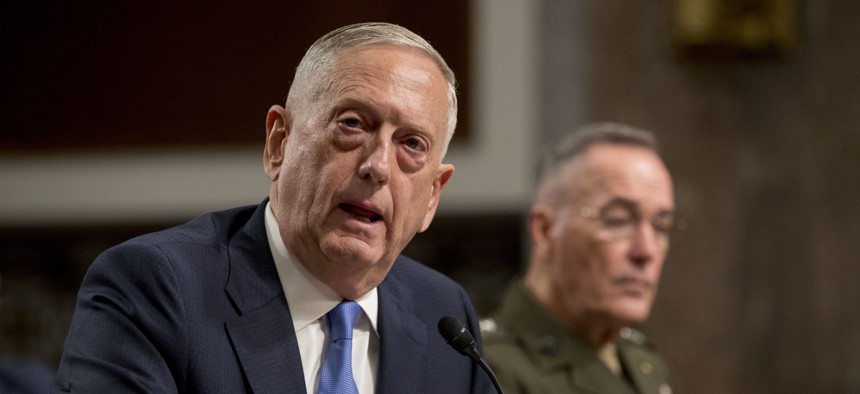
U.S. Defense Secretary Jim Mattis, left, accompanied by Joint Chiefs Chairman Gen. Joseph Dunford, speaks on Afghanistan before the Senate Armed Services Committee on Capitol Hill in Washington on Oct. 3, 2017. Associated Press / Andrew Harnik
The US Will Be Dropping A Lot More Bombs on Afghanistan
More air support for Afghan forces will help drive the Taliban to the negotiating table, Mattis and Dunford tell Congress.
Sixteen years into America’s war in Afghanistan, the Pentagon has a new strategy it says will help bring the conflict to an end. A large part of it: Intensifying the U.S.- and NATO-led air campaign in order to drive the Taliban to the negotiating table.
Defense Secretary Jim Mattis said the U.S. wants to embolden the Afghan forces by providing close air support and intelligence, surveillance, and reconnaissance assets. That will make them more effective, in turn convincing the Taliban and other extremist groups that “you’re not going to be able to win this by killing.”
“Having fought in mountainous country, it’s unpleasant to have the enemy above you,” Mattis told lawmakers today. “NATO airstrikes overhead denies the enemy ever having the high ground and in turn the dominating terrain. That’s a tactical effect that…will give them militarily more opportunities to take fight to the enemy.”
An intensified air war is one of the new tactical aspects of a broader strategy that Mattis and the Chairman of the Joint Chiefs of Staff, Gen. Joseph Dunford, debuted at a pair of congressional hearings with the Senate and House Armed Services Committees today. The administration’s new strategy is called “R4+S,” which stands for regionalize, realign, reinforce, reconcile and sustain.
The second R, “realignment,” will push U.S. advisors and trainers down to Afghan forces’ battalions, and the third, “reinforce,” means adding 3,000 or so U.S. troops to help do so, Mattis said. In recent years, U.S. advisors have been embedded only at the senior levels of the conventional Afghan military and with the Afghan special forces.
“Two levels down below is where the decisive action is taking place, and we didn’t have any advisors,” Dunford said. “So even though we had some aviation capabilities, some intelligence, surveillance and reconnaissance capabilities, it wasn’t being delivered to those Afghan units who were perhaps most relevant to the fight.”
That means more Afghan forces — there’s 300,000 all told today, both officials said — will have U.S. troops with them capable of requesting air strikes around the country.
And the targets they’ll be able to strike have expanded as well.
“At one time, sir, we could not help Afghan forces unless they were in extremis” — that is, under direct, urgent threat, Mattis said. “And then eventually that was rescinded, but they still had to be in proximity. They had to be in contact. Today, wherever we find them, the terrorists — anyone trying to throw the NATO plan off, trying to attack the Afghan people and the Afghan government — then we can go after them.”
Throughout 2014 and 2015, the U.S. Air Force released an average of 95 bombs a month in Afghanistan. The air campaign began ramping up last year, when President Barack Obama’s administration accepted a recommendation from Gen. John Nicholson, then newly leading the U.S. mission in Afghanistan, to permit offensive air strikes against the Taliban.
Compare that with August, the most recent month for which data is available: That month, the U.S. Air Force dropped 500 bombs in support of Operation Resolute Support — the first time it had done so in more than five years, a Military.com analysis found.
Those numbers could jump, now that President Donald Trump gave Mattis the freedom to remove the “proximity” requirement. Any individual or group that threatens not just U.S., coalition or Afghan forces, but the government more broadly, is able to be targeted by U.S. air support — even if they’re not physically close to U.S. troops.
“The conditions aren’t specific to, as Sec. Mattis alluded to, a specific engagement or a specific time,” Dunford added. “So if they’re in an assembly area, a training camp, and we know they’re an enemy and a threat to the Afghan government, our mission or our people, Gen. Nicholson has the wherewithal and flexibility to make that decision.”
All told, that means more potential opportunities to drop bombs, and more people embedded at the levels to identify such opportunities.
More U.S. advisors on the ground, and close to the action, to provide guidance overstrikes could help limit civilian casualties. A 2016 investigation by U.S. Central Command into a deadly strike on a Doctors Without Borders hospital in the Kunduz region found that not having a joint terminal attack controller, or JTAC, close to the action contributed to the deadly strike. The closest JTAC was miles away, also pinned down by gunfire in a separate firefight.
One Army intelligence officer with extensive experience in the region said that embedding more advisors at the battalion level and removing the proximity restriction were positive developments.
“Afghans continue to suffer from an inability to provide coordinated fires on legitimate targets,” said the officer, who spoke anonymity because he was not authorized to speak publically on the Defense Department policy issues. “Their Collateral Damage estimates, or CDEs, leave much to be desired. So having advisers at the battalion level provides another layer of oversight and advising/mentoring on the value of getting accurate targeting information.”
But the officer also had concerns that the moves would to deepen U.S. involvement in the fight without providing a clear way out.
“My concern is with mission creep. The more we seek to take on the burden of fighting the Taliban ourselves, even if it is only through indirect strike capability, the more we deny the Afghans the ability to grow comfortable fighting the fight and relying on their own organic structures/ assets. It's a ‘rob Peter to pay Paul’ sort of situation.”
Mattis acknowledged that there had been situations where “many Afghan Army units that never had advisors and had a very convoluted way to get that air support.” This “organizational problem” would be remedied by the new approach, he said.
But a number of lawmakers were skeptical that a ramped-up bombing campaign would be sufficient to end America’s longest-running war.
“So do we think that just because there’s now air cover for troops, the Afghan army, that that’s going to be enough to bring [the Taliban] to the table?” said Sen. Jeanne Shaheen, D-N.H.
Mattis and Dunford emphasized it was just part of the broader regional strategy designed to bring about a political reconciliation. That, and three other goals, are achievable, the Pentagon’s top civilian and military officer assured lawmakers.
“If you define winning as making sure we don’t have another attack on the homeland from the terrorist organizations that operate in South Asia … we can do that,” Dunford said. “If winning includes getting the Afghan forces to the point where they can provide security for their country with a minimal amount of international support, we can do that. If winning includes meeting [Afghan] President [Ashraf] Ghani’s goals for security of the population in key economic areas, we can do that.”
How soon? Dunford agreed with Nicholson’s assessment from earlier this year that, at least right now, the war is at a “stalemate.”
Patrick Tucker contributed to this report.
NEXT STORY: Here’s How Much of Your Taxes Have Gone To Wars




